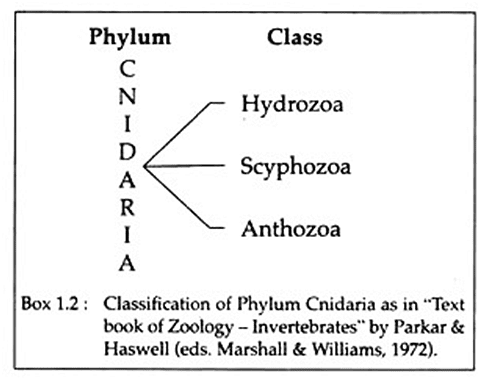Cnidaria: Classification and Features | Zoology Optional Notes for UPSC PDF Download
| Table of contents |

|
| Classification of Phylum Cnidaria |

|
| Diagnostic Features of Phylum Cnidaria |

|
| Scheme of Classification of Phylum Cnidaria |

|
| Systematic Resume |

|
Classification of Phylum Cnidaria
The phylum Cnidaria is a diverse group found worldwide and includes various species like hydras, transparent jellyfish, colorful sea anemones, and different types of corals, totaling about 10,000 aquatic species.
- Leuckart established the phylum Coelentarata in 1847, which initially included sponges and ctenophores.
- In 1888, Hatschek divided Leuckart's Coelenterata into three distinct phyla: Spongiaria (Porifera), Cnidaria, and Coelenterata.
- Cnidarians are primarily marine organisms that can be either sessile or free-swimming, existing as solitary individuals or in colonies.
- They are characterized by radial symmetry, with two cell layers and a gut cavity lined by endoderm.
- Cnidarians have vibratile tentacles arranged in one or more whorls around their mouths, equipped with nematocysts, which are stinging organs.
- Cnidarians represent a pioneering stage in the evolution of tissue organization.
Diagnostic Features of Phylum Cnidaria
- Most members are aquatic, primarily marine, with a few exceptions.
- The body is diploblastic, consisting of two tissue layers: an outer ectoderm (epidermis) and an inner endoderm (gastrodermis), with a less cellular mesoglea in the center.
- Two distinct body forms exist: the "medusa" (sexual phase) adapted for a pelagic lifestyle and the "polyp" (asexual phase) adapted for a benthic lifestyle.
- They display radial symmetry.
- There is no head or body segmentation.
- The presence of short, slender tentacles arranged in one or more whorls around the mouth.
- The body contains an internal space for digestion known as the "gastro-vascular cavity," with the mouth serving as the sole opening.
- Cnidarians can perform both intracellular and extracellular digestion.
- The body wall consists of specialized cells called "Cnidocytes," which house stinging organelles called "nematocysts."
- They are acoelomates due to the absence of a coelom.
- Cnidarians lack respiratory, circulatory, and excretory systems, relying on gas exchange through diffusion.
- Their nervous system is primitive, consisting of a diffuse network of unpolarized nerve cells.
- Reproduction occurs both asexually through budding and sexually through the production of ova and sperm. Development often involves a bilaterally symmetrical, ciliated larva known as a "planula."
- Their life history often demonstrates the phenomenon of metagenesis.
Scheme of Classification of Phylum Cnidaria
The classification of Cnidarians by Parker and Haswell or as revised by Marshall and Williams, 1972 (7th edn.), is very much similar to that of Ruppert and Barnes (1994), except that the later authors have introduced an additional class-Cubozoa, for the medusoid cnidarians with bells.
The classificatory scheme followed in this text is based on the scheme outlined by Ruppert and Barnes, 1994 (6th Edn.)
 |
Download the notes
Cnidaria: Classification and Features
|
Download as PDF |
Systematic Resume
Class Hydrozoa (Greek: hydro, water serpent)
- Individuals are either exclusively polyploid or medusoid or constituted by both forms in the life cycle.
- Mesoglea acellular.
- Cnidocytes are confined to the epidermal layer.
- Coelenteron is undivided and without stomodaeum.
- Gonads are usually ectodermal in origin or if endodermal, gametes do not escape through the coelenteron and mouth.

Class Scyphozoa (Greek: skyphos, cup)
- Medusoid form is dominant in the life cycle; polypoid form is very insignificant.
- Mesoglea is cellular.
- Some cnidocytes are endodermal.
- The endodermal gastric tentacles are present.
- Velum is absent.
- Gonads are endodermal.
Example: Aurelia, Pilema, Lucernaria, Pericolpa. Class Cubozoa (Greek: Cubo, cube)
- Medusoid cnidarians with bells.
- Body is distinctly flattened to form four sides.
- Bell margin simple.
- Presence of velum along the margin of the medusa.
- There are four tentacles or tentacle clusters at the four corners of the margin.
- Body wall possess a type of nematocyst called stenotale.
Examples: Carybdea, Chiropsalmus, Chironex, Tripedalia
Class Anthozoa (Greek: Anthos, flower)
- Exist only in the polypoid form.
- Mesoglea cellular.
- Some cnidocytes are endodermal.
- Stomodaeum strongly developed.
- Extending between the stomodaeum and the body-wall there are mesenteries.
- Gonads are endodermal.
- Members are exclusively marine.
Subclass Octocorallia/Alcyonaria
- Polyp with eight tentacles and eight septa (mesenteries).
- Mesenteries are complete.
- Tentacles are pinnately branched.
- Only one ventral siphonoglyph is present.
- Almost entirely colonial, usually connected by coenenchyme.
Subclass Hexacorallia / Zoantharia
- Polyps with more than eight tentacles and septa, typically in cycles of 12.
- Tentacles are hollow and un-branched.
- Usually two siphonoglyphs are present.
- Solitary or colonial.
Examples: Sea-anemones (Adamsia, Edivardsia, Metridium) A, Fungia (mushroom coral) B, Astrea (star coral) D, Antipathes, Meandrina (brain coral) C.
|
181 videos|346 docs
|




















